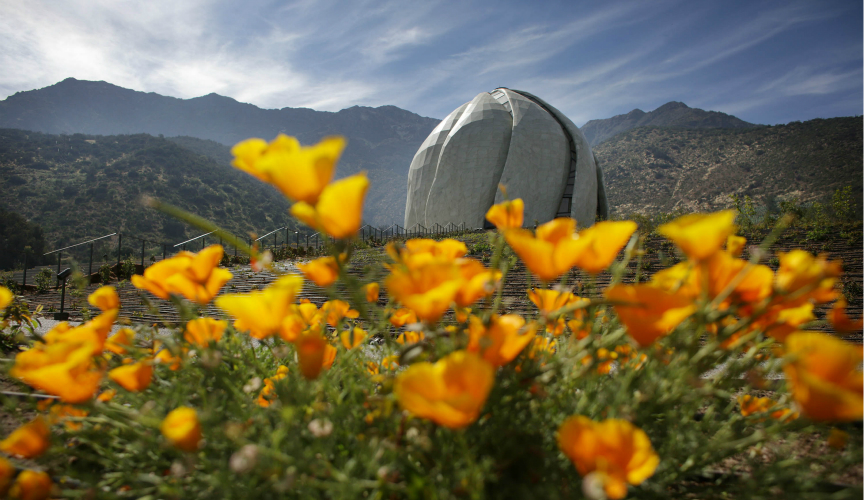Source: impresa.elmercurio.com
Translation by Iran Press Watch

Open to the public since mid-October, the Bahá’í House of Worship for South America, located in the Andean foothills of the community of Peñalolén, attracts more and more visitors every day, and is becoming established as an unforgettable sight for people of all beliefs. Javier Contreras
“Brilliant day out with lovely people,” read the official Instagram account of the British group New Order this Monday, which performed the night before in the Teatro Caupolicán, and used the day to tour the capital. The caption was accompanied by a photograph of the members of the band with representatives of the local production company that brought them back to Chile. In the background, an imposing structure in the shape of a flower that shines in the middle of the mountainous landscape of Santiago.
It is impossible that such a building, which reaches 30 meters in height, goes unnoticed if one looks towards the Eastern zone of the city. Its construction, which began six years ago on a six-hectare plot of land in the community of Peñalolén, stirred up curiosity, especially during the last two years when the monumental wings made of molten glass and translucent marble began to rise, nine in total, which form the bud. Many wondered what the giant object was in the middle of nowhere, why it was there; whether it was private or public.
The mystery was clarified this past October 19th when the first Bahá’í Temple of South America was inaugurated. “Without rituals or clergy, without icons or images, the Bahá’í temples seek to reflect an ideal of universal worship, where men, women, and children can come together as equals,” explains the Bahá’í community of Chile, who settled in the country in the 1940s. In the 80s and 90s, they experienced a growth that culminated in 2001 with the plan to erect the first House of Worship for South America and the eighth in the world.
With six million followers in 247 countries, the Bahá’í Faith, is founded upon the teachings of Bahá’u’lláh, a nobleman of Persia –now Iran- who in the mid nineteenth century proclaimed that all creeds come from a single source. Each is understood as a successive chapter of the sole religion of God with its respective messenger for each era: from Abraham to Krishna, from Zoroaster to Moses, from Buddha to Jesus, and Muhammad to Bahá’u’lláh himself, the most recent of them. “The fundamental purpose animating the Faith of God and His Religion is to safeguard the interests and promote the unity of the human race, and to foster the spirit of love and fellowship amongst men,” predicts Bahá’u’lláh, for whom the solution to the problems of humanity can be solved through the unification of it’s peoples.
Adoration and dialogue with the city
This is a space of unity welcome to the whole community. The idea is that everyone, regardless of their religion, background, ethnicity, or gender, can pray, meditate, and reflect in silence inside the temple, or simply roam the serene gardens filled with native flowers, and appreciate the extraordinary view of Santiago,” explains Eduardo Rioseco, director of the Bahá’í Temple of South America. He suggests that the location of the building in the Andean foothills proposes an ongoing dialogue between the city, nature, and the spirit.
In February of this year, during the final phase of it’s construction, the dean of the architecture department at the Universidad del Desarrollo (University of Development), Pablo Allard, assured “El Mercurio” (a local Chilean newspaper) that “from an urban, touristic, and architectural point of view,” the temple was shaping up to be “a world-wide destination”. The intendant of Santiago, Claudio Orrego, reaffirmed that view when he attended the buildings’ inauguration in October: “The temple has an important tourist potential”.
The House of Worship, which can be accessed on Diagonal Las Torres 2000, just at the end of Avenida Grecia, is already receiving thousands of people each week, particularly Saturdays and Sundays (Mondays it is closed to the public). The visitors, who range from children to the elderly, climb a stairway that takes them to the esplanade where the temple stands surrounded by gardens and fountains, and whose brilliance invites contemplation and reflection as much from the outside as the inside (there isn’t artificial light thanks to the translucent materials).
Sculptor Olga Disi, who visited the site recently, recommends the experience. “What man creates can never outshine nature, but to think that this was conceived without trying to hinder it’s surroundings, I think it is worth seeing,” she states. Carmen González, a friend of the artist, remembers the stillness of the space. “The peacefulness it makes you feel compared to the bustle of the city is magnificent.”
Javier, a student of the University Adolfo Ibáñez, visits the site frequently and claims that it offers a space of spiritual connection. “The first time you go, you want to see how beautiful and novel it is, but afterwards, when you come to meditate, it helps you to reconnect with your own self,” he says. Analena, a teacher and neighbor from Peñalolen who visited the temple intrigued by it’s mysteriousness agrees: “The construction is magnificent. But once inside, it’s so tranquil, there’s so much devotion; it’s a place to be silent, to meditate, think, read, or whatever is born of the spirit.”
Leave a Reply